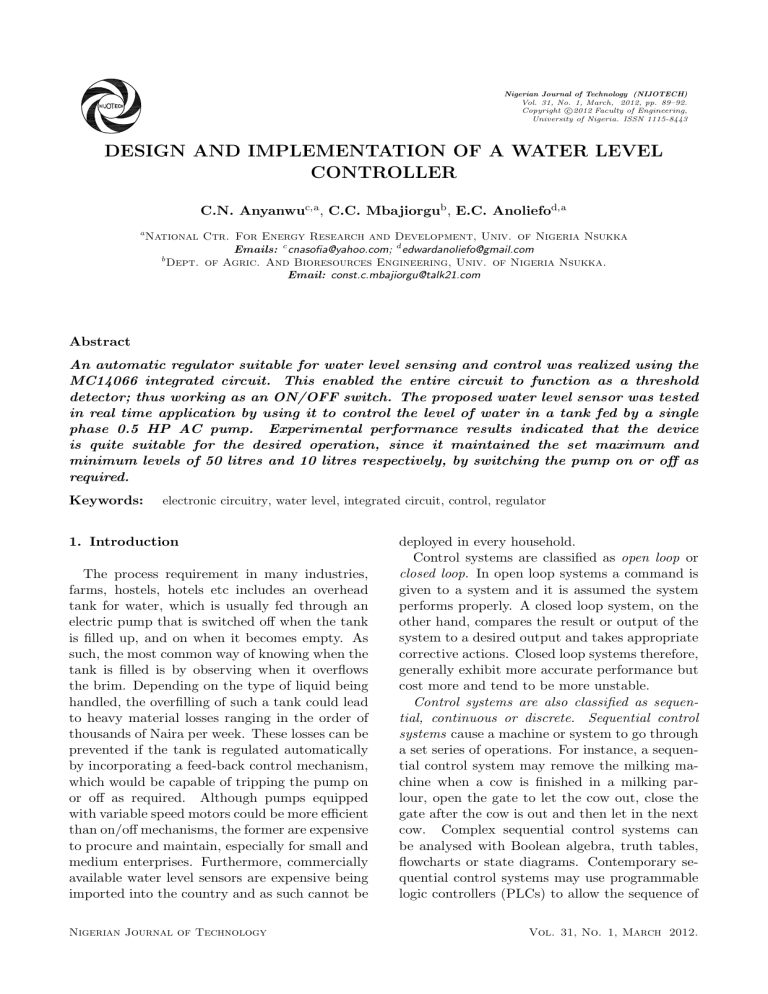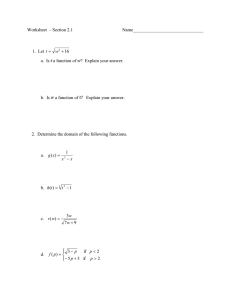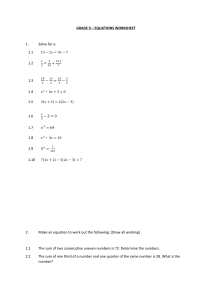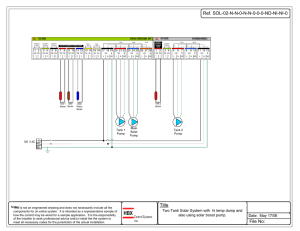
Nigerian Journal of Technology (NIJOTECH) Vol. 31, No. 1, March, 2012, pp. 89–92. Copyright c 2012 Faculty of Engineering, University of Nigeria. ISSN 1115-8443 DESIGN AND IMPLEMENTATION OF A WATER LEVEL CONTROLLER C.N. Anyanwuc,a , C.C. Mbajiorgub , E.C. Anoliefod,a a National Ctr. For Energy Research and Development, Univ. of Nigeria Nsukka Emails: c cnasofia@yahoo.com; d edwardanoliefo@gmail.com b Dept. of Agric. And Bioresources Engineering, Univ. of Nigeria Nsukka. Email: const.c.mbajiorgu@talk21.com Abstract An automatic regulator suitable for water level sensing and control was realized using the MC14066 integrated circuit. This enabled the entire circuit to function as a threshold detector; thus working as an ON/OFF switch. The proposed water level sensor was tested in real time application by using it to control the level of water in a tank fed by a single phase 0.5 HP AC pump. Experimental performance results indicated that the device is quite suitable for the desired operation, since it maintained the set maximum and minimum levels of 50 litres and 10 litres respectively, by switching the pump on or off as required. Keywords: electronic circuitry, water level, integrated circuit, control, regulator 1. Introduction The process requirement in many industries, farms, hostels, hotels etc includes an overhead tank for water, which is usually fed through an electric pump that is switched off when the tank is filled up, and on when it becomes empty. As such, the most common way of knowing when the tank is filled is by observing when it overflows the brim. Depending on the type of liquid being handled, the overfilling of such a tank could lead to heavy material losses ranging in the order of thousands of Naira per week. These losses can be prevented if the tank is regulated automatically by incorporating a feed-back control mechanism, which would be capable of tripping the pump on or off as required. Although pumps equipped with variable speed motors could be more efficient than on/off mechanisms, the former are expensive to procure and maintain, especially for small and medium enterprises. Furthermore, commercially available water level sensors are expensive being imported into the country and as such cannot be Nigerian Journal of Technology deployed in every household. Control systems are classified as open loop or closed loop. In open loop systems a command is given to a system and it is assumed the system performs properly. A closed loop system, on the other hand, compares the result or output of the system to a desired output and takes appropriate corrective actions. Closed loop systems therefore, generally exhibit more accurate performance but cost more and tend to be more unstable. Control systems are also classified as sequential, continuous or discrete. Sequential control systems cause a machine or system to go through a set series of operations. For instance, a sequential control system may remove the milking machine when a cow is finished in a milking parlour, open the gate to let the cow out, close the gate after the cow is out and then let in the next cow. Complex sequential control systems can be analysed with Boolean algebra, truth tables, flowcharts or state diagrams. Contemporary sequential control systems may use programmable logic controllers (PLCs) to allow the sequence of Vol. 31, No. 1, March 2012. 90 C.N. ANYANWU, C.C. MBAJIORGU & E.C. ANOLIEFO +.-+ *-4- . 4-+.--. 5-4- . 6 +.+-+ Figure 1: Schematic of the tank and regulator. *-4-. Figure 2: Schematic of the Sensor Assembly. 5-4-. control to be modified in software rather than requiring hardware or connection changes. Continuous control systems are the usual subject of control theory analysis [1, 2, 3]. Such systems are physical systems in which the input-output behaviour of the system can be described by ordinary differential equations in time. Many of the components have a relationship that can be modelled as a constitutive equation of the relationship of a through variable to an across variable. For instance, the current through an electrical component or the fluid flow through an orifice can be related to the voltage across or the pressure across that component. This paper, therefore, dwells on the design and implementation of a simple but effective feedback regulator for use in water level sensing and control. Nigerian Journal of Technology 2. Regulators for Level Control The two traditional methods of finding the level of water in a tank are either by tapping down the side of the tank until the sound suddenly changes, or by removing the tank cover and dipping in a measuring stick [4]. The first method is notoriously unreliable, while the second method can be awkward and time-consuming. A more advanced method of sensing the water level in a tank utilizes various electronic circuitry developed for different applications. Many different circuits have been developed and deployed for water level sensing [4] based on integrated circuit technology and the output signal from a water sensor can be harnessed in a form suitable for regulating the level. Using electronic devices to accomplish on/off switching is not an entirely new thing. According to [5] who captured an informal version of the evolution of the microprocessor, the transistor developed by Bell Laboratories in 1947 was intended to replace vacuum tube to switch electronic signals on or off. It was, however, not until 1959 that the integrated circuit or IC was developed at Texas Instruments. Of special interest in the present work is the MC14066, which is an IC used to accomplish specialized tasks. In Vol. 31, No. 1, March 2012. 91 Design & Implementation of Water Level Controller " ! " # ! Figure 3: Functional block diagram of MC14066. Nigeria, there are no known realized circuitry for water level sensing and control till date as such devices are usually imported. 3. Design of the Automated Control System The envisaged system, which is a closed loop control device (Fig. 1), makes use of liquid level as input to control power supply to a liquid pump. Thus the output is a discrete variable (on/off) actuated using an electronic circuit. Liquid level will be monitored using two electronic sensors placed at the appropriate positions to detect the low and high values. The output signal is fed into the electronic circuit, where it is transduced into on or off signal that controlspower supply to the pump. A schematic diagram of the entire system comprising tank, regulator and pump is shown in Fig. 1. The major advantage of the system derives from the fact that it is not limited to the size and nature of the liquid tank. Thus, an existing liquid tank (of any material) can be converted into a control tank by simply fitting a regulator sensor inside it and connecting the circuitry. The sensor selected for this work (Fig. 2) functions based upon the principle of electrical conductivity of water due to the presence of dissolved salts. Thus, the metallic conductor is encased in a plastic tube, in which the water level rises simultaneously as in the main tank. equipped with inlet and outlet pipes. The single phase electric pump used is a 0.5 hp (i.e. 0.37 kW) capacity, Model MKP- 60 product of Oceanic Water Pump company. The basic active element in the water level indicator is MC14066. The MC14066B consists of four independent switches capable of controlling either digital or analog signals. Each switch has three pins - one input, one output and one control as shown in Fig. 3. When voltage is at the input, it would usually not be transferred to the output except when there is a signal at the control. The above feature of the integrated circuit is used in the design of the water level indicator. In the design under consideration, all that is required is to get the pump to stop working when the water level reaches a certain height and to get it to start working when it reduces to a certain height. To achieve this, we take advantage of the conductivity of water (or any other liquid that has an appreciable level of electricity conduction). For the purposes of the work, a 12V dc was sent to the input while the output is grounded through a 100k resistor. The 12Vdc would not complete its electrical path unless there is a signal from the control. To get signal to the control pin only when there is water, the control pin is grounded through a 100k resistor. Another wire that hangs at a desired height for contact with water is also connected to the pin. Another 12Vdc was then sent into the tank. As a result, when there is no water in the tank, the connection to the control pin is open circuited and the 100K resistor pulls the voltage down. As the liquid level increases, the liquid creates an electrical contact that generates a signal at the control pin. The circuit diagram is presented in Fig. 4. 4. Construction Materials for the Liquid Tank and Regulator 4.1. The water tank and electric pump The liquid tank was fabricated out of G14 galvanized iron sheet, which was folded and welded into the desired cylindrical shape with twice the diameter as effective height. The tank is Nigerian Journal of Technology At the point the signal is generated, an electrical contact is created between the input and the output. Since the output is grounded through a resistor, a positive voltage is created at one end of the resistor. The voltage is then used to trigger the base of TIP31(a transistor), which is, in turn, used to trigger a relay that is able to put the pump on/off. Vol. 31, No. 1, March 2012. 92 C.N. ANYANWU, C.C. MBAJIORGU & E.C. ANOLIEFO Figure 4: Circuit diagram of the water level controller. 4.2. Performance evaluation of the realized system In order to carry out performance testing of the developed system, it was connected to a 0.37 KW (0.5 Hp) AC water pump (although any other AC pump can be used) and used to supply water to the overhead tank. The maximum level was set at 50 litres whereas the minimum was 10 litres. The pump was connected through the control device (regulator), whereas the sensor was immersed in the tank and connected to the regulator by well insulated output cables. The pump was put on and allowed to supply water to the tank. As soon as the water level reached the high level, the regulator switched off the pump. To test the low level sensor, water was drawn from the tank continuously until the low level was attained at which point the regulator automatically switched the pump on. Thus, the regulator successfully maintained water level between these limits as long as there was power supply to the system. 5. Conclusion and Recommendations An automatic water level regulator was designed and constructed using available materials and successfully tested at the University of Nigeria, Nsukka. The electronic circuitry was realized using available simple components such as Nigerian Journal of Technology integrated circuits centred on the MC14066 integrated circuit. The tank was made using galvanized iron sheet whereas the sensor assembly was encased in a plastic tubing and submersed in water. Performance evaluation of the system indicated that it can regulate water level within a specified range, an indication that it can be applied for reducing energy and material losses in the process industry, small and medium scale enterprises as well as in farms, homes etc, where water and other ionic chemicals are usually stored in overhead tanks. References 1. Dorf, R.C. and R.H. Bishop. Modern Control Systems, 10th ed. Upper Saddle River, NJ: Prentice-Hall, 2005. 2. Ogata, K. Modern Control Engineering, 4th ed. Upper Saddle River, NJ: Prentice-Hall, 2002. 3. Wells, R.L., J.K. Schueller and J. Tlusty. Feedforward and Feedback Control of Flexible Robotics Arm. IEEE Control Systems 10(1) 1990: 9-15. 4. Anon. Water Level Sensor. Accessed from the website: http://www.siliconchip.com.au/cms/ A 30607/article.html on 15th May 2009. 5. Garetz, M. Evolution of the Microprocessor: An Informal History. Byte, 10th Anniversary Issue, 1985. Vol. 31, No. 1, March 2012.





